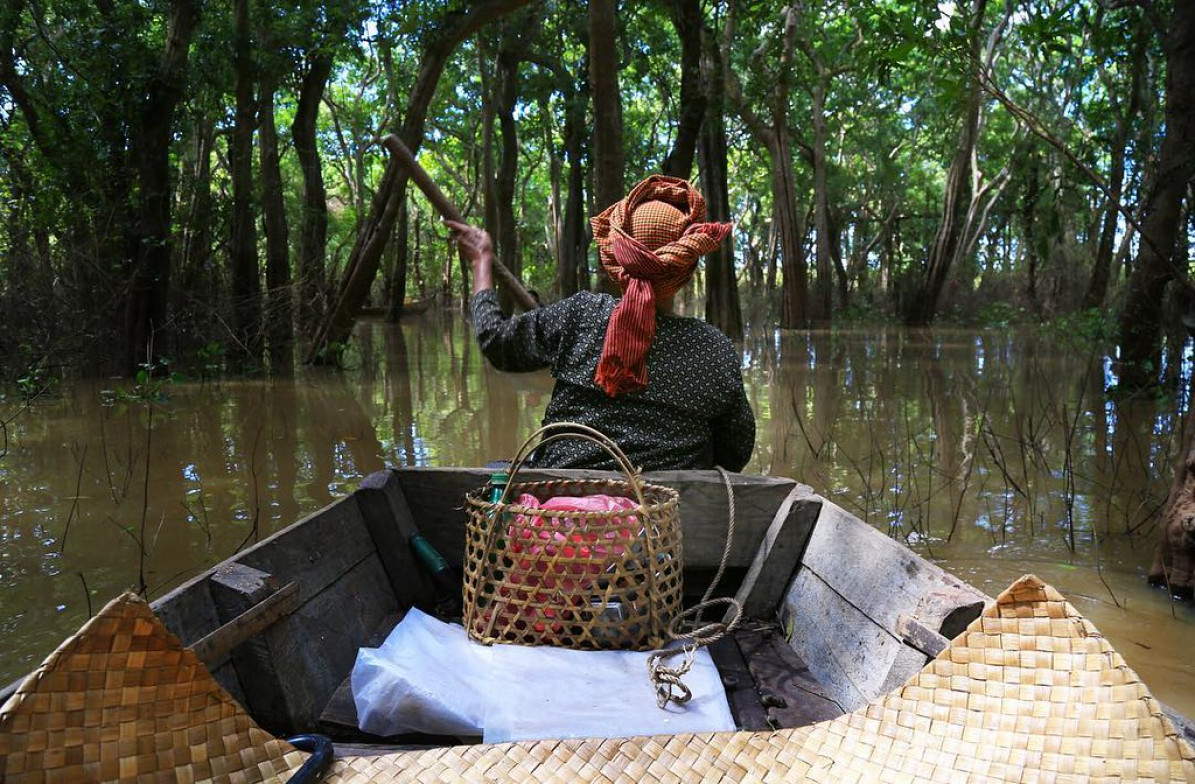
Women's Participation in Forest Management Decisions: Challenges, Impacts, and Ways Forward

Written by: Vanly Keomuda, a 4th year student majoring in International Studies at The Royal University of Phnom Penh
Editted by: Heng Kimkong, a Visiting Senior Research Fellow at Cambodia Development Center and a PhD Candidate in Education at The University of Queensland, Australia

(Photo Credit: "Floating in a forest 🌳 in these days of chaos, anger, heartbreak, injustice and fear i couldn't wish more for the quiet and beauty of nature... . . . . . . #beginningoftheend #nature #climatechange #beauty #cambodia #forest #travel" by franci castelli is licensed under CC BY-NC-ND 2.0)
When talking about the forest and its ecosystem, the most common discussion that we normally hear is the environmental services of the forest system that serves as the hub for biodiversity, the filter for the increasing greenhouse gas emission, and the regulator of the global carbon cycle and weather patterns. Besides the ecological benefits, forests also serve as essential economic and livelihood resources. According to the Food and Agriculture Organisation, nearly 1.6 billion people (around 25% of the world’s population) depend on forest resources as their source of food and income. The forest products provide people living near the forest with food, cooking and heating fuel, medicine, shelter and clothing, as well as income from selling the surplus of non-timber forest products (NTFP).
In Cambodia, forest products are also one of the Cambodian people’s livelihood sources since 80 per cent of the country’s population are living in rural areas. They are more likely to depend on the forest and its resources. In the forest-dependent community, women are amongst the groups that depend most on the forest resources for their daily lives. Women tend to collect forest products and other NTFPs in the nearby forest for their household use. According to a recent USAID report, 80 per cent of women in rural Cambodia are involved in collecting and selling NTFPs. Even though both men and women may equally rely on forest products for their daily lives, women tend to be left out or are underrepresented when it comes to decision-making regarding forest management. In 2015, only 12 per cent of Forest Administration staff were female and less than 1 per cent were in management positions in both national and sub-national forest institutions. This suggests that women’s voices are underrepresented when it comes to making forest decisions that could impact their access to and usage of forest resources.
Challenges for women to participate in forest management decision making
Even though Cambodia’s Forestry Law has provided a legal framework for the involvement of user groups in forest management and protection (which includes women), women still find it difficult to participate in forest management decisions. The challenges for women to participate in forest management decision making could stem from the existing gender norms and institutional challenges.
In terms of gender norms, although Cambodia is working on narrowing gender inequalities, patriarchy prevails in society, including in the forest sector. As a result, women’s voices and interests in forest management tend to be overlooked by their own forest communities. Furthermore, the traditional perception that women should work indoors in the kitchen has also discouraged women to work far from home or engage in any technical and physical forestry activities such as involvement in forest patrol. Even when women are keen to participate in forest management, they tend to be reluctant and lack confidence in their own capacity, thereby deterring them from actively participating in forest management efforts.
On top of the societal norms, there are still some challenges in the gender mainstreaming process in forest policies and institutions. The 2003 sub-decree on Community Forest Management has a provision to encourage women to participate in the Community Forestry Management Committee (CFMC); however, the sub-decree did not specify the gender quota for women’s participation. As a result, women’s meaningful participation in forest management is limited as less than 10 per cent of community forestry groups have achieved a satisfactory level of women’s participation, However, less than 5 per cent of women hold management positions in the CFMC. Furthermore, the gender working group that was established in the Forest Administration is facing limited financial and human resources, resulting in their inability to effectively implement the gender plan, conduct research, and monitor as well as evaluate the gender mainstreaming activities in the forest sector.
Thus, it could be seen that although women are eager to participate in forest management, the remaining traditional norms and institutional challenges remain major barriers for women to fully participate in forest management decisions.
Positive impacts of women’s participation in forest management decisions
As mentioned above, women are also highly dependent on forest products; thus, their involvement in forest management decisions is significant in ensuring that the benefits from the forest products are equally distributed between men and women. Furthermore, the involvement of both women and men in forest management decisions is crucial for effective forest management and conservation since women could share different knowledge, skills, and experiences about forests. A 2013 study in Thailand showed that women are knowledgeable about market demand for forest products, especially non-wood forest resources. They also have an understanding of the impact of weather patterns on the availability of forest products. Therefore, women’s involvement in forest management planning plays a significant role in formulating forest rules and regulations that are socially accepted. In addition, studies have also shown that women’s participation in forest management decisions could also improve forest governance. For example, communities that have more women involved in the forest committee tend to have better forest conditions and forest regeneration. Therefore, women’s involvement in forest management decisions tends to lead to better institutional functioning of forest conservation, good governance, and fair sharing of forest resources.
Ways forward
Seeing the benefits of women’s involvement in forest decisions on forest conservation and reforestation, women should be encouraged to participate in forest management decisions in Cambodia. In doing so, Cambodia’s government and relevant stakeholders should consider the following recommendations:
- The government and CFMC should continue to focus on providing capacity development training for women on technical forestry skills and confidence building so that women could be confident in involving in forest-related activities and forest management decisions.
- The government and relevant stakeholders should continue to spread awareness of the benefits of women’s involvement in forest management as well as providing training on gender equality and gender analysis. In doing so, it could encourage men to promote women’s involvement and to raise awareness on gender-specific issues when formulating forest rules and regulations.
- Projects and programmes that are working on forest sectors in Cambodia should mainstream and integrate gender equality in their work-plan and agenda in order to encourage more women involvement in forest-related activities.
- The government should discuss setting gender quotas in CFMC to ensure that women are properly represented in CFMC.
- Furthermore, adequate resources, including financial and human resources should be allocated to gender working groups and gender focal points in the forest administration so that they could effectively implement gender mainstreaming activities as well as providing relevant support.
Taking everything into account, women's involvement in forest management decisions is significant in ensuring that the forest rules and benefits are acceptable and equally distributed amongst the groups that rely on forest resources. This would consequently lead to good forest governance and improve forest conservation and reforestation in Cambodia. Therefore, it is imperative that women should be encouraged to participate in forest management through capacity development as well as through institutional means that recognise the need for women’s involvement in forest management decisions. Women themselves should also step up and seek opportunities to participate in forest management and conservation efforts to ensure that their needs and interests are adequately addressed.
*This blog is produced with the financial support from the European Union and The Swedish International Development Cooperation Agency through Transparency International Cambodia and ActionAid Cambodia. Its contents do not reflect the views of any donors.




